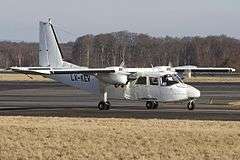2016 Sunbird Aviation crash
On 13 April 2016, a Britten-Norman BN-2T Turbine Islander operated by Sunbird Aviation crashed about 1,200 m (0.65 nmi; 0.75 mi) short of runway number 7 at Kiunga Airport[1] in the Western Province of Papua New Guinea. The plane had pitched up right before the crash, and then dropped its right wing and fell almost vertically to the ground.[2] Eleven passengers (including three children) and the 31 year old Australian pilot, Benjamin Picard,[3] were killed. Nine people died on impact, with other three declared dead on arrival at Kiunga Hospital.[4][5][6][7]
 A Turbine Islander similar to the accident aircraft | |
| Accident | |
|---|---|
| Date | April 13, 2016 |
| Summary | Engine failure, improper loading, stall |
| Site | Kiunga, Papua New Guinea |
| Aircraft | |
| Aircraft type | Britten-Norman BN-2T Turbine Islander |
| Operator | Sunbird Aviation |
| Registration | P2-SBC |
| Flight origin | Tekin Airport, West Sepik, Sandaun Province, Papua New Guinea |
| Destination | Kiunga Airport, Kiunga, Western Province, Papua New Guinea |
| Occupants | 12 |
| Passengers | 11 |
| Crew | 1 |
| Fatalities | 12 |
| Survivors | 0 |
The investigation determined that an engine failure occurred in mid-flight. The aircraft was loaded significantly aft of the center of gravity limit. Upon extension of the aircraft's flaps, an uncontrollable pitch up resulted in the aircraft stalling and spinning into the ground.
Flight
The flight was a non-scheduled domestic chartered passenger flight from Tekin, West Sepik Province (Sandaun) to Kiunga, Western Province. The flight was under Visual Flight Rules, in which pilots are not allowed to fly if the weather is inclement. The flight was operated by Sunbird Aviation, a small non-scheduled aviation company based in Goroka, with a Britten-Norman BN-2T Turbine Islander, registered as P2 – SBC. The flight was carrying 11 passengers, including 3 children, and an Australian pilot, identified as Benjamin Andre Picard.[8]
The flight took off from Kiunga at 13:56 and later reached Oksapmin. Picard then reported to Kiunga that the flight was on Kiunga's circuit area and began to fly a left circuit to land at Kiunga. The weather in Kiunga, at the time, was in good condition. Picard then configured the aircraft for landing.[8]
As the flight approached Kiunga, it suddenly pitched up in a nearly vertical condition. Due to the vertical motion, the right wing stalled and the aircraft rolled to the right. It then fell rapidly, struck trees and slammed onto the ground. The aircraft impacted at a nearly 90° angle. Due to the force of the impact, the front part was crushed and the tail snapped. 9 people were killed instantly.[9]
Witnesses reported the crash to the airport and subsequently located the crash site. 3 people were extricated alive from the crash site and were transported to Kiunga Hospital. However, they were later pronounced dead on arrival. All 12 passengers and crews on board were killed.[10]
Investigation
Papua New Guinea AIC sent two investigators to the crash site. Representative from the aircraft's manufacturer Britten-Norman was also invited to join the investigation. Initial examination of the wreckage was hampered due to bad weather condition. The wreckage was left unattended for five days due to inundation around the area. It was later taken to Kiunga on the sixth day.[8]
There were reports that the pilot of the flight, Benjamin Picard, made an emergency call to the authorities in Kiunga. Seconds later, the aircraft pitched vertically and crashed. Investigators dismissed the report. However, investigators later confirmed that the right engine had failed in mid-flight. It happened while the aircraft was approaching Kiunga. Evidences found on the right engine proved that an engine failure had occurred in mid-flight. This causing the propeller to auto feather as it was shutting down, but that the compressor was still spooling down at impact.[8]
Further investigation revealed that the centre of gravity of the aircraft had shifted significantly to the aft centre. As a result, the aircraft pitched up severely when the pilot extended the flaps.[8]
It is usual for aircraft to pitch up when the pilots extended the flaps. The possibility for the aircraft to pitch up is even greater when the pilots extended the flaps for an approach.[8]
The accident flight was aggravated by the fact that the centre of gravity of the aircraft was shifted to the aft. When the pilot extended the flaps, the aircraft pitched up. However, because the centre of gravity was located at the aft, it would be difficult to pitch the nose down. Examination on the wreckage revealed that the flaps, at the time, were fully extended and that Picard, during the stall, had made a full nose down input, to no avail. Investigators added that there was no evidence that the pilot calculated the aircraft loaded balance for the flight. The actual weight and balance of the aircraft could not be conclusively determined.[8]
Investigators later added that recovery from the stall was impossible due to the low height of the aircraft.[8]
The investigation concluded that the right engine failure caused the aircraft to lose its lift force. The improper loading of the cargo aggravated the condition.[8]
References
- "2016-04-13 Sunbird BN-2A Islander". Islander Crashed.
- "2016-04-13 Sunbird BN-2A Islander". Database Record.
- "Australian News". Australian News.
- "Australian pilot among 12 people killed in Papua New Guinea plane crash". The Sydney Morning Herald.
- Accident description for Britten-Norman BN-2T Turbine Islander P2-SBC near Kiunga Airport at the Aviation Safety Network. Retrieved on 13 April 2016.
- "12 perish in plane crash in Kiunga". PNG Facts.
- "Crash killed all 12: Yalo – The National".
- "Final Report" (PDF). AAIB.
- Tlozek, Eric. "Australian among 12 killed in Papua New Guinea plane crash". ABC. Retrieved 23 December 2017.
- Pokiton, Sally. "Three Survived Initial Impact: PNG AIC". Loop PNG. Retrieved 23 December 2017.